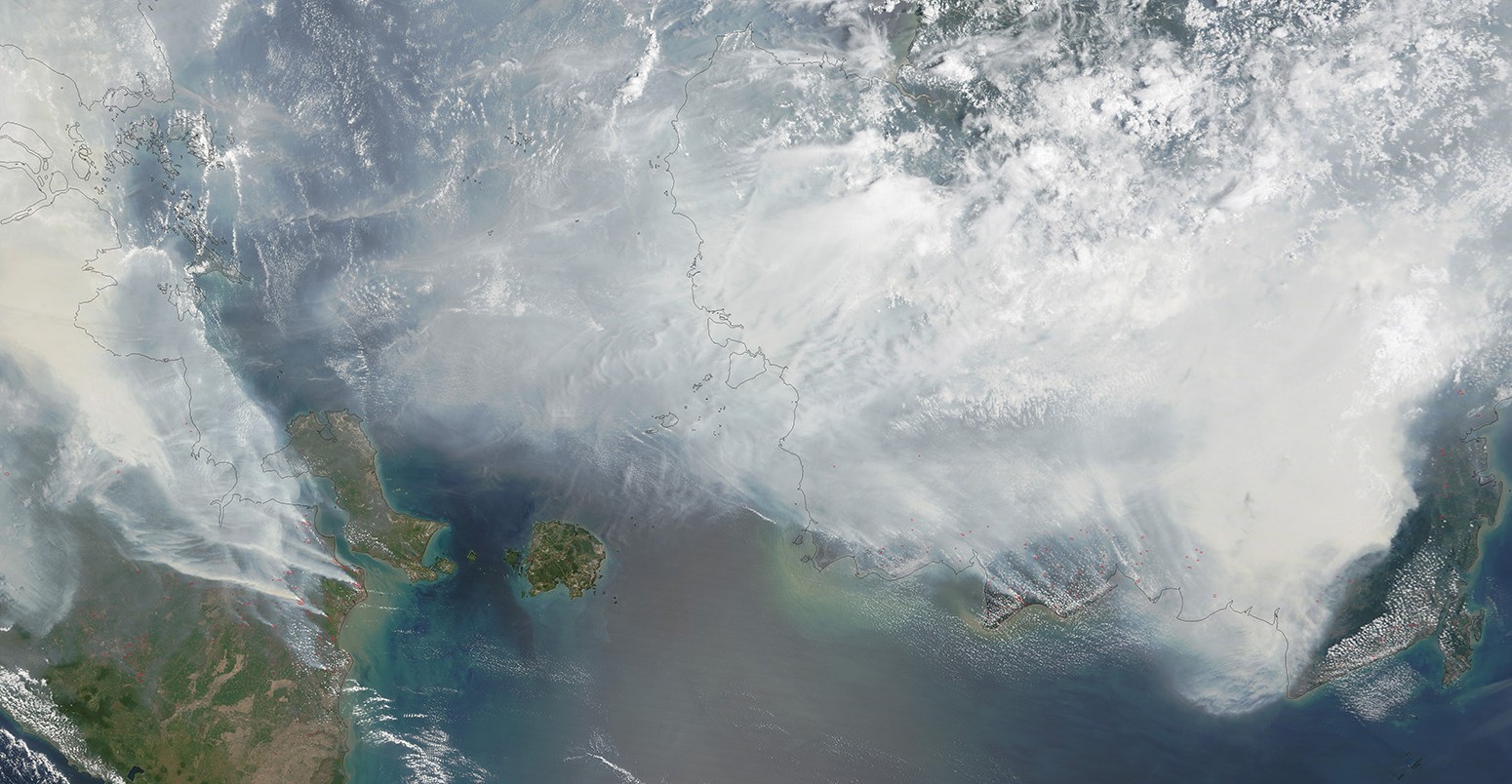Indonesian fires now on a par with Brazil’s total annual emissions
Roz Pidcock
10.29.15Roz Pidcock
29.10.2015 | 6:07pmFires are raging across Indonesia, so far releasing almost as much carbon to the atmosphere as Brazil produces in a year, according to new data from the World Resources Institute.
Standing at a staggering 1.6bn tonnes of greenhouse gases, emissions from Indonesia’s fires alone are already twice as high as those from the rest of economy combined, and have bumped Indonesia up from the sixth biggest emitting country to the fourth in just six weeks.
With the international community keeping close watch ahead of the Paris talks next month, here’s a summary of the state of play and some context on what it means for the climate.
‘Slash and burn’
Each year in Indonesia, fires typically burn from July to October when the land is dry. The country has long attracted the international spotlight because a large proportion of the fires are started deliberately to clear land for palm oil, used widely in food, cosmetics and household products.
Initially sanctioned by the government in the early 1980s, this is now illegal. However, it continues largely unpoliced. So far, 2015 has seen the second highest number of fires on record, with 117,878 fires currently burning, according to estimates by the Global Fire Emissions Database (GFED).
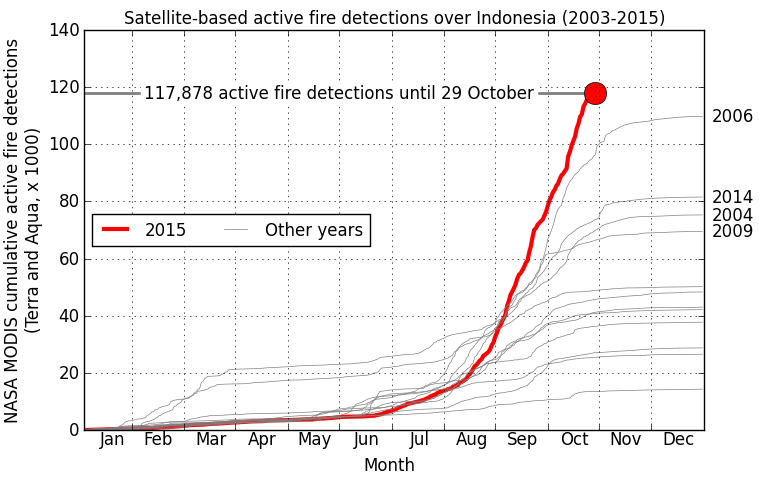
Active fires detected over Indonesia as of 29 Oct 2015. Source: Global Fire Emissions Database
1997 holds the record for the highest number of fires in a single year, attributable in part to the huge El Niño that peaked in December of that year. El Niño isn’t the root cause of fires, but it reduces rainfall in the region, making the land drier and more susceptible to fire.
A climate issue
The rapidly-spreading fires are threatening wildlife, including the iconic orangutan. Smoke from the fires has closed schools, caused flight cancellations and affected an estimated half a million people with respiratory illnesses. Ten people are reported to have died as a result of the fires.
But there’s another problem. One with big consequences for the climate.
Indonesia is home to 84% of Southeast Asia’s peatlands. It is also the world’s largest producer of palm oil, with 52% of the global supply. That means a lot of the land earmarked to meet the growing demand for oil palm is the carbon-rich peatlands, which, when burned or drained, release large amounts of carbon dioxide and other greenhouse gases to the atmosphere.
You can see the heavy smoke from fires in Borneo in the satellite image below, taken on 19 October. The red dots represent individual fires, detected from space by the heat they give out.

Smoke from fires burning over Borneo on Oct 19th. Source: NASA Earth Observatory
Fourth highest emitter
So far this year, Indonesian wildfires have released an estimated 1.6bn tonnes of CO2 equivalent, according to the GFED.
Dr Guido van Werf, who runs the GFED, tells Carbon Brief the uncertainty associated with these figures could be up to 50%.
But, if correct, this figure suggests emissions from the Indonesian fires alone are on a par with the total emissions Brazil produces in a year from energy, agriculture and land use combined.
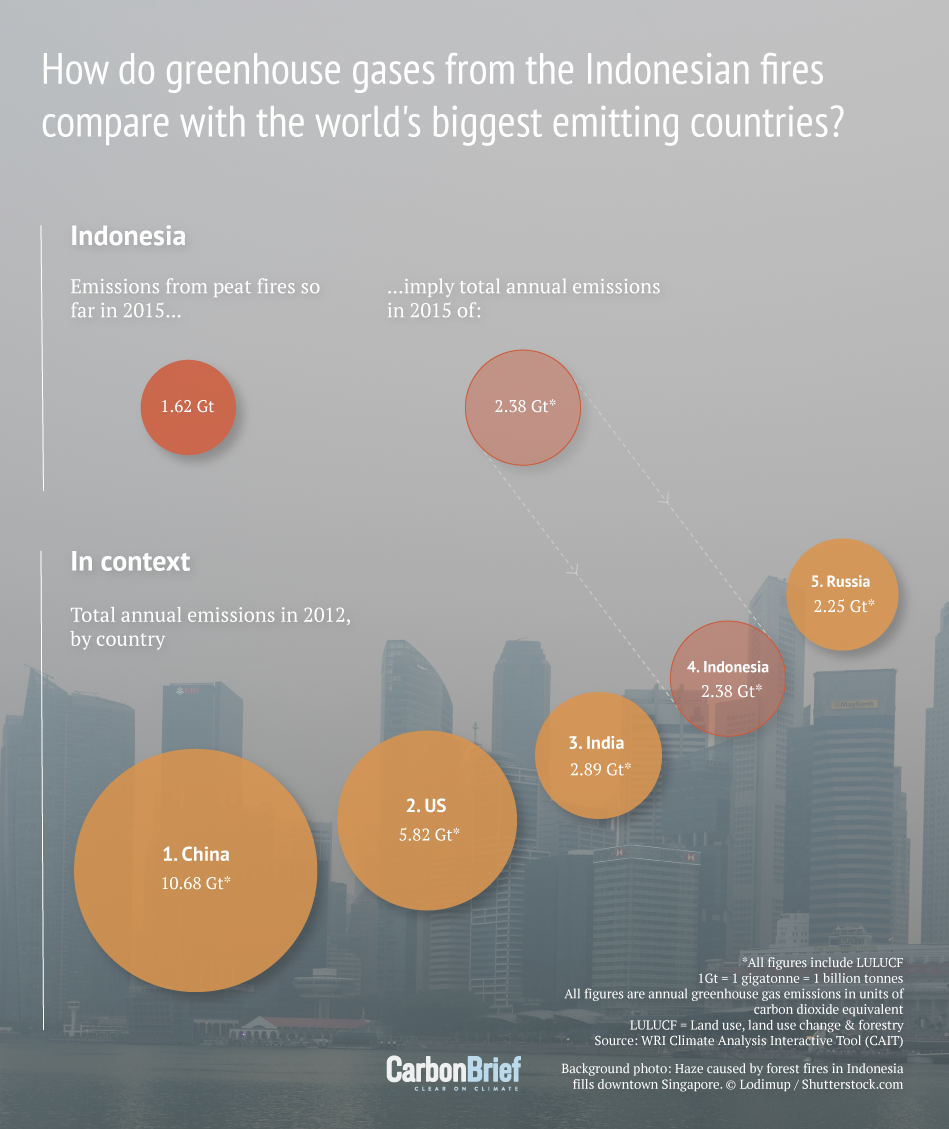
Infographic: How do greenhouse gases from the Indonesian fires compare with the world’s biggest emitting countries? By Rosamund Pearce for Carbon Brief
With emissions excluding land use at around 760 Mt CO2 equivalent, this year’s fires have already emitted more than twice the emissions from all Indonesia’s other sectors put together.
Together, this suggests Indonesia currently accounts for 3.4% of total annual global emissions (based on 2012 figures), putting it above Russia and behind China, the US and India as the fourth largest emitting single country in the world.

Fire emissions from Indonesia as of 29 Oct 2015. Source: Global Fire Emissions Database
On some particularly fire-intensive days, emissions from the Indonesian fires have been higher than those from the whole of the US economy. The WRI analysis suggests this was true for 38 days out of the past 56. A separate Bloomberg analysis suggests Indonesia’s daily fire emissions also exceeded total daily emissions from China on at least 14 days in the past two months.
Outlook
With emissions already staggeringly high, this year’s fire season isn’t over yet, say scientists.
The start of the rainy season usually extinguishes the fires, but scientists expect the strong El Niño to mean the rainy season arrives later than usual. The most recent forecast is for below-normal rain for the next two weeks, as the yellow shapes across Indonesia in the maps below show.
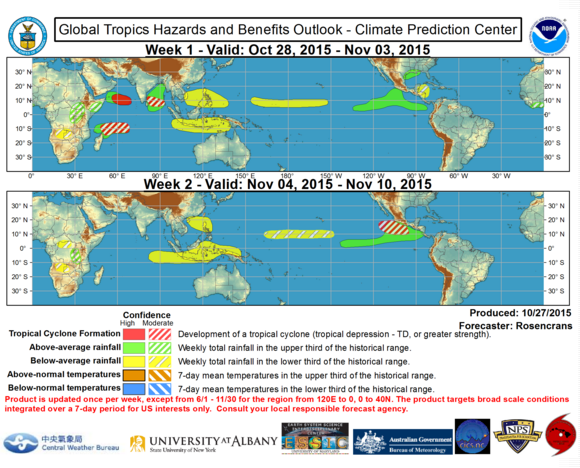
Latest forecast showing lower-than-average rainfall expected over Indonesia for the next two weeks. Source: NOAA National Weather Service, Climate Prediction Center
There has, at least, been some relief. An update this morning on the GFED says:
Most forecasts still indicate lower than average rainfall for the next weeks or months, but some rain has arrived and the number of active fire detections has dropped substantially since 26 October.
But the picture isn’t shifting dramatically just yet, says Dr Robert Field, a research scientist at Columbia University and NASA. He tells Carbon Brief:
Heavy rains have historically returned to the regions currently burning (southern Sumatra, south-central Kalimantan, Irian) in mid-November. There has recently been sporadic rain, but not enough to stop the fire and haze.
During the big El Niño in 1997, Indonesian fires released 4.3bn tonnes of carbon dioxide equivalent, according to the GFED. A similar figure this year would see total annual emissions surpass those for India (based on 2012 figures), bumping Indonesia up another place to third behind China and the US in the list of highest emitters.
But Field thinks 1997 is likely to retain the top spot, given that the fire season got underway a month earlier than it did than this year. Dr David Gaveau from the Centre for International Forestry Research agrees, tells Carbon Brief:
2015 is tracking somewhere between 1997 and 2006 [the most recent year with an El Niño]. 1997 will likely remain worse in terms of drought and forest area burned.
A crisis in context
Indonesia isn’t the only place where fire is a problem.
The graph below from the GFED shows how annual greenhouse gas emissions from different types of fires in Indonesia compare to other parts of the world.
The top panel shows that, globally, emissions from all types of fire show a modest decrease since 1997. Other regions also have higher total annual fire emissions than Indonesia.
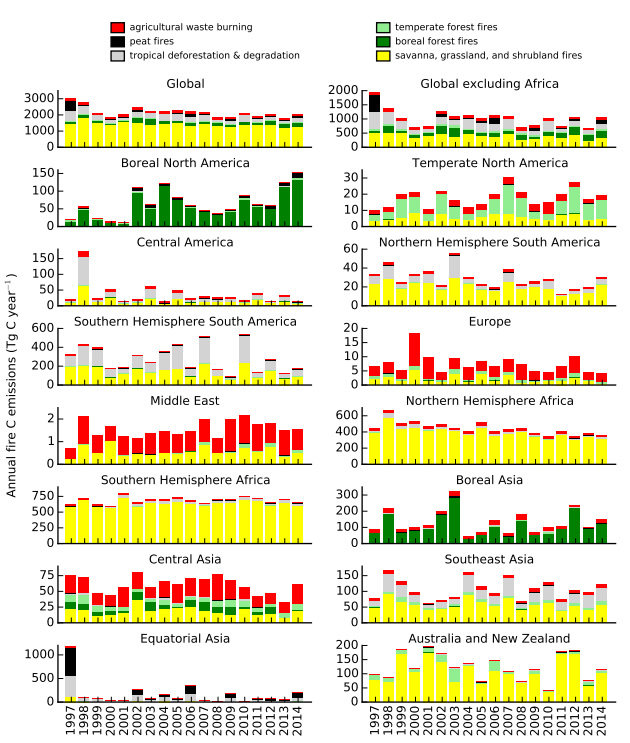
Annual emissions from different types of fire across the world. Black bars represent those from peat fires. Source: GFED
But the type of fire is important in determining the climate impact, says van der Werf. He tells Carbon Brief:
Keep in mind emissions from most other countries are not net carbon dioxide emissions as in Indonesia. It is simply a natural cycle.
With most types of fire, carbon emissions tend to be re-absorbed by vegetation as it regrows. But burning peat is a net source of carbon because it releases CO2 that has been locked away for hundreds of years. And, as the black bars in the graphs above show, equatorial Asia is responsible for almost all global emissions from peatland fires.
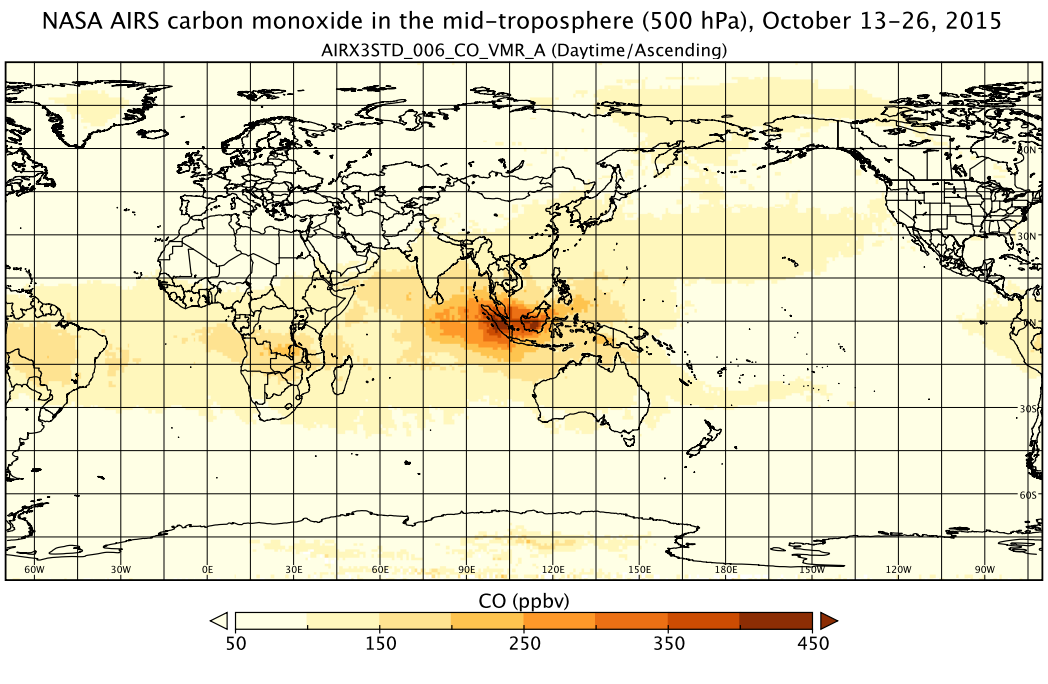
Carbon monoxide in the atmosphere between 13-26 Oct 2015, showing the effects of Indonesian peat fires stretching from India to the Philippines. Source: NASA
So, are the Indonesian fires the “worst climate crisis on the planet right now”, as parts of the media have dubbed them?
While van der Werf agrees the emissions from these fires are huge, they are still dwarfed by other global emissions sources such as fossil fuels and agriculture. He tells Scientific American:
I do think we will see the impact of these fires on the global carbon dioxide concentration, but in the end it is a minor source if you take the full picture into account. Everything is relative.
Prof Nancy Harris, research manager for Global Forest Watch at the Word Resources Institute, takes a different view, telling Carbon Brief:
On average, emissions from fires in Indonesia are less important for climate change than emissions resulting from the fossil fuels that drive our global economy. This year, however, the concentrated pulse of emissions arising from Indonesian fires in such a short period of time is almost unprecedented, and is occurring at a time when we are trying our hardest to find ways to limit emissions to keep global warming below 1.5 degrees.
Dr Fred Stolle, a senior scientist with WRI’s Forests Program, adds:
You see these enormous amount of greenhouse gases in such a short time only in disasters, like big wildfires in the USA or Australia or volcano eruptions.
Indonesia has the highest deforestation rate in the world, with land use and peat fires accounting for 63% of emissions. But with the US and Europe both major consumers of palm oil, the escalation in production (red bars below) is partly to satisfy the demand from the West.
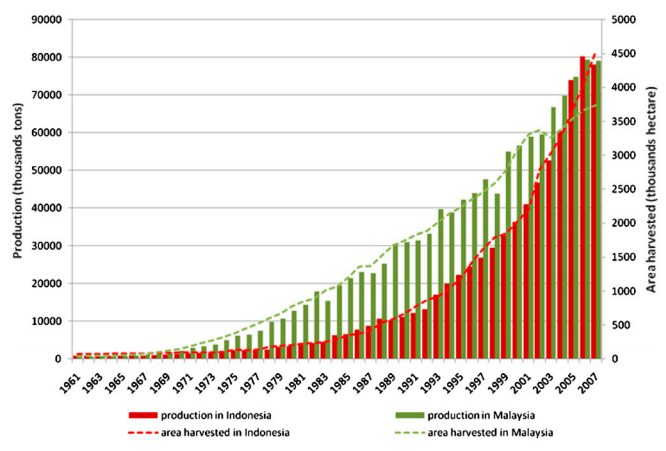
The growth of oil palm production in Indonesia (red) and Malaysia (green) up to 2010. Source: Mudiyarso et al., (2010)
Indonesia has pledged to reduce its emissions by 29-41% by 2030, compared to business as usual. As this Carbon Brief article explains, this would amount to preventing any increase on recent levels, though the upper end of the range depends on receiving international financial support.
The government says the 2030 emissions target will be met partly through “improved land use”, though details of how this will be achieved remain fuzzy.
As the fires continue to rage, it remains to be seen what the climate impact will be. El Niño is providing the conditions for the fires to proliferate, but while the root cause of the fires continues largely unfettered, the stark images and statistics make for a dramatic backdrop to the looming Paris talks, where a global deal to tackle emissions is due to be struck.
Main image: Thick grey smoke from forest fires across Indonesia on Sep 24th 2015, taken with the Moderate Resolution Imaging Spectroradiometer (MODIS) instrument on the Terra satellite.
-
Indonesian fires now on a par with Brazil's total annual emissions
-
Indonesia bumped from 6th to 4th biggest carbon emitter in 6 weeks due to fires


